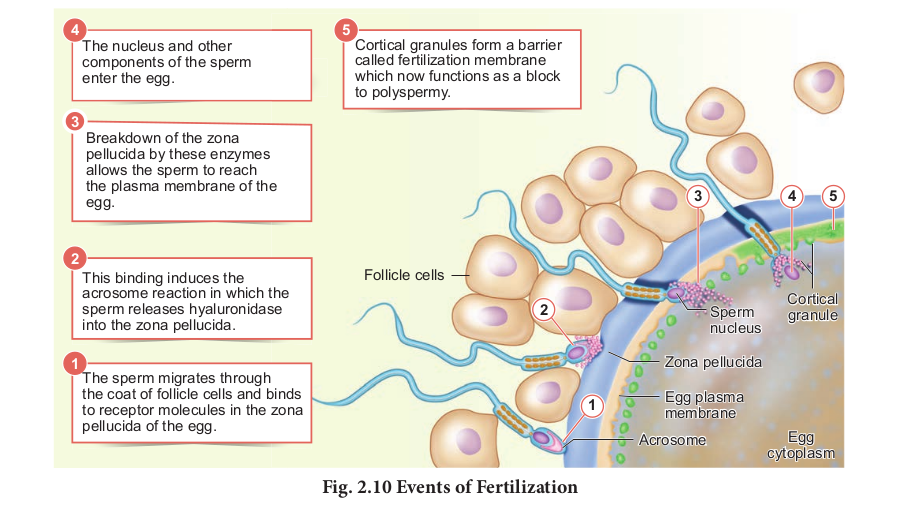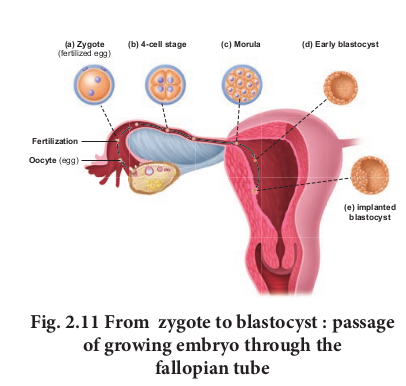Fertilization and implantation
Fertilization occurs when a haploid spermfuses with a haploid ovum to form a fertilized egg or diploid zygote.
The sperms deposited in the female reproductive tract undergo capacitation, which is a biochemical event that enables the sperm to penetrate and fertilise the egg. Fertilization occurs only if the ovum and sperms are transported simultaneously to the ampullary isthmic junction of the fallopian tube.
Before a sperm can enter the egg, it must penetrate the multiple layers of granulosa (follicular) cells which are around the ovum forming the corona radiata (Fig. 2.10). The follicular cells are held together by an adhesive cementing substance called hyaluronic acid. The acrosomal membrane disintegrates releasing the proteolytic enzyme, hyaluronidase during sperm entry through the corona radiata and zona pellucida. This is called acrosomal reaction. Once Fertilization is accomplished, cortical granules from the cytoplasm of the ovum form a barrier called the Fertilization membrane around the ovum preventing further penetration of other sperms. Thus polyspermy is prevented.
The first cleavage produces two identical cells called blastomeres. These produce 4 cells, then 8 and so on. After 72 hours of Fertilization, a loose collection of cells forms a berry shaped cluster of 16 or more cells called the morula (Fig. 2.11).
Under the influence of progesterone, smooth muscles of the fallopian tube relax and the dividing embryo takes 4-5 days to move through the fallopian tube into the uterine cavity and finally gets implanted in the uterine wall. At this point the embryo consists of a fluid filled hollow ball of about 100 cells, called the blastocyst. The blastocyst is composed of a single layer of large flattened cells called trophoblast and a small cluster of 20-30 rounded cells called the inner cell mass. The inner cell mass of the blastocyst develops into the embryo and becomes embedded in the endometrium of the uterus. This process is called implantation and it results in pregnancy.
If the fertilized ovum is implanted outside the uterus it results in ectopic pregnancy. About 95 percent of ectopic pregnancies occur in the fallopian tube. The growth of the embryo may cause internal bleeding, infection and in some cases even death due to rupture of the fallopian tube.


Twins are two offsprings produced in the same pregnancy.
➢ Monozygotic (Identical) twins are produced when a single fertilized egg splits into two during the first cleavage. They are of the same sex, look alike and share the same genes.
➢ Dizygotic (Fraternal) twins are produced when two separate eggs are fertilized by two separate sperms. The twins may be of the same sex or different sex and are non-identical.
➢ Siamese (United) twins are the conjoined twins who are joined during birth.